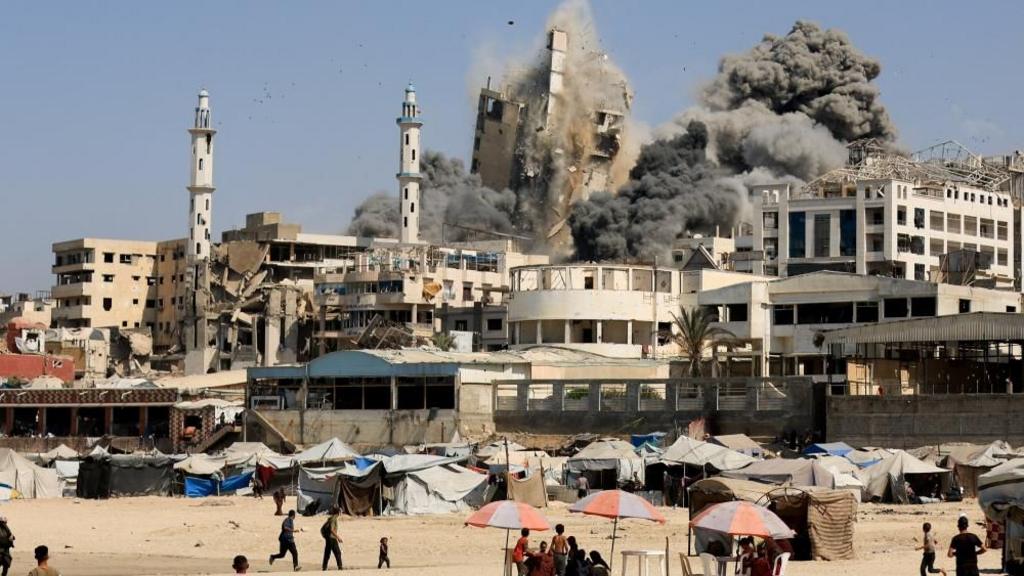Gaza City Offensive: Palestinians Fleeing Amid Israel’s Major Ground Assault
Introduction
Gaza City, the densely populated urban center of the Gaza Strip, has once again become the epicenter of conflict as Israel launches a major ground offensive. What began as an intensification of aerial bombardments has now escalated into street-by-street fighting, forcing tens of thousands of Palestinians to flee their homes in search of safety. The offensive marks one of the most significant escalations in recent years, with devastating humanitarian consequences.
This article examines the unfolding situation: the military strategy, the humanitarian toll, the voices of civilians caught in the crossfire, and the wider geopolitical implications of this offensive.
Background to the Conflict
The Gaza Strip, home to over 2.3 million people, has long been a flashpoint in the Israeli-Palestinian conflict. Over the past year, tensions have steadily escalated, with rocket fire, airstrikes, and cross-border attacks creating a volatile cycle of violence.
Israel has justified its latest military operations as necessary to neutralize militant groups operating out of Gaza, particularly Hamas. However, critics argue that the scale of the offensive is disproportionate and has endangered civilians in one of the world’s most densely populated regions.
The latest ground assault is part of Israel’s broader campaign to weaken Hamas’s military capabilities, dismantle its tunnel network, and restore what Israeli officials call “security and deterrence.”
The Ground Offensive Unfolds
Reports from Gaza describe Israeli tanks and troops entering northern and central Gaza, with Gaza City itself seeing some of the fiercest battles. Entire neighborhoods have been flattened by artillery fire, and residents describe the sound of gunfire, explosions, and drones filling the skies day and night.
Israeli forces have focused on what they identify as Hamas strongholds, including densely populated residential areas. This has left civilians trapped between militant activity and military bombardments, creating chaotic and dangerous conditions for anyone attempting to flee.
Mass Displacement of Palestinians
The United Nations has reported that tens of thousands of Palestinians have fled Gaza City and surrounding districts since the offensive began. Families are packing into cars, donkey carts, and even leaving on foot with only what they can carry. Many are heading south toward Khan Younis and Rafah, but nowhere in Gaza is truly safe, as Israeli strikes continue across the territory.
One displaced resident, speaking to aid workers, described the harrowing journey:
“We walked for hours under the sound of bombs. My children were crying from fear and hunger. We don’t know where to go anymore. Every place they tell us is safe is later bombed.”
Displacement has become a recurring reality for Gazans, many of whom have already fled multiple times in previous conflicts. But the scale of this latest offensive has created one of the largest waves of displacement in years.
Humanitarian Catastrophe
The humanitarian situation in Gaza is deteriorating rapidly. Hospitals are overwhelmed, many operating with dwindling supplies of medicine, fuel, and electricity. Doctors report treating hundreds of wounded civilians daily, often under extreme conditions with limited equipment.
The blockade on Gaza has made resupplying hospitals and shelters extremely difficult. Aid organizations, including the United Nations Relief and Works Agency (UNRWA), warn that food, clean water, and shelter are critically scarce.
UN Secretary-General António Guterres has described the situation as “a humanitarian catastrophe,” calling for an immediate ceasefire to allow aid to reach civilians. However, diplomatic efforts have so far failed to produce a breakthrough.
Civilian Voices from Gaza
The stories emerging from Gaza paint a picture of resilience and suffering. Parents describe struggling to shield their children from both physical danger and psychological trauma. Teachers who once led classrooms now lead groups of children through bombed-out streets, trying to find shelter.
One mother told reporters:
“We are constantly moving. First, we left our home in the north. Then we went to relatives in Gaza City. Now we are told to move south again. We carry our babies and whatever food we can find, but there is no place left that is safe.”
For many Palestinians, the repeated cycles of displacement and destruction have left them feeling hopeless, but their voices continue to call for international solidarity and intervention.
Israel’s Justification
Israeli officials maintain that the ground offensive is necessary to dismantle Hamas’s military infrastructure. They point to rocket attacks on Israeli towns and cities, as well as the killing and kidnapping of Israeli civilians, as justification for their military campaign.
Prime Minister Benjamin Netanyahu has stated:
“Our goal is clear: to defeat Hamas and restore security to the people of Israel. Every operation we conduct is aimed at dismantling terrorist capabilities. Unfortunately, Hamas uses civilians as human shields, and this makes the battle both complex and tragic.”
Israel has urged civilians to evacuate targeted areas through leaflets, text messages, and radio broadcasts, but critics argue that in a besieged strip with no exits, such warnings do little to protect lives.
International Reactions
The offensive has drawn strong reactions globally.
The United States has reiterated its support for Israel’s right to defend itself but urged restraint to minimize civilian casualties.
European Union leaders have expressed concern over the humanitarian crisis, with several calling for an immediate ceasefire.
Arab states, including Egypt and Jordan, have condemned the scale of the offensive, warning that regional stability could be at risk.
The United Nations has called repeatedly for humanitarian corridors to be opened, but these calls have yet to materialize in practice.
The geopolitical dimension of the conflict remains deeply complex, with each side entrenched in narratives of defense, survival, and resistance.
The Role of Humanitarian Organizations
International aid organizations have been scrambling to respond, but their efforts are hampered by constant bombardments and restrictions on access. Shelters are overflowing, and reports indicate that diseases are beginning to spread due to overcrowding and poor sanitation.
Humanitarian workers describe the situation as “apocalyptic,” noting that even those who survive the bombings may die from hunger, thirst, or lack of medical care if aid cannot get through.
The Psychological Toll
The long-term impact on Gaza’s children is especially alarming. UNICEF has warned that children are experiencing unprecedented levels of trauma, with many suffering from nightmares, anxiety, and symptoms of post-traumatic stress disorder.
Teachers and psychologists working in makeshift shelters are attempting to provide emotional support, but the ongoing violence makes healing nearly impossible. Generations of children in Gaza have now grown up knowing little but war, displacement, and uncertainty.
Possible Outcomes
While the full scope of the offensive is still unfolding, analysts suggest several possible outcomes:
Escalation – If the offensive continues unchecked, casualties will rise, displacement will spread, and the humanitarian crisis will deepen.
Ceasefire under international pressure – Global outrage may eventually force both sides into a temporary truce.
Prolonged conflict – Israel may attempt to hold territory in Gaza for weeks or months, leading to sustained fighting.
Political fallout – The offensive could reshape regional alliances and influence internal politics in both Israel and Palestine.
What remains certain is that civilians will continue to bear the brunt of the violence, regardless of political or military outcomes.
Conclusion
The Israeli ground offensive in Gaza City has triggered mass displacement, immense suffering, and an unfolding humanitarian crisis. Palestinians fleeing the city are left with nowhere truly safe to go, as bombardments and fighting spread across the strip.
Parents’ testimonies of fear, loss, and resilience highlight the human dimension of a conflict often reduced to numbers and political statements. While Israel defends its campaign as a fight against terrorism, the human toll on Gaza’s civilian population is undeniable.
As the world watches, the question remains: will global powers step in to enforce a ceasefire and humanitarian relief, or will Gaza continue to endure yet another devastating chapter in its long history of conflict?
For now, the people of Gaza City continue to flee, survive, and cling to hope amid destruction.



